Abstract
In performance sports, diagnosis is crucial in achieving all aspects of training management: setting educational and performance instructive objectives; preparing training to maximize the strengths of each athlete in the context of external environment opportunities and remedying weaknesses from the perspective of inherent threats; developing an individualized training strategy. The aim of the paper is to provide good practice models for our domain specialists in terms of determining objective parameters for diagnosis and prognosis in some branches and sports events. The paper proposes an investigation logistics with modern instruments, apparatus and techniques, a methodology for evaluation and appreciation of some parameters of the speed of reaction to different stimuli, the static and dynamic balance, general and segmental, explosive force, anaerobic power, reactive force, foot amplitude, in correlation with the objective parameters of the specific training. Thus, we emphasize the elements of the management of the sports diagnosis, depending on the particularities of the various sport disciplines and sports events in an individualized way. We used a complex modern logistics: the Sensamove balance platform, Opto Jump Next, the nautical conditions computer-assisted simulator for testing and training, logistics provided by the Laboratory of Research Center for Human Performance, University of Pitesti. The subjects of the research are performance athletes from two sports fields (Athletics and Bobsleigh) from CSU Pitesti, CSM Bucharest, SCM Campulung, LPS Campulung. The results confirm the working hypothesis and offer possibilities for technological transfer in other branches as well.
Keywords: Assessmentmeasurementperformancetraining
Introduction
Athletes' training is a complex educational process due to the many plans that sports training require, plans that are intertwining and influencing mostly one to another (Nicu, 1993; Manno, 1996; Weineck, 1997; Dragnea, & Teodorescu, 2002).
In the management of sports training, we must take into account, on one hand, the performance’s premises and, on the other hand, the structure of the performance capacity (Dragnea, & Teodorescu, 2002, p.155). A developed management should take into account the five functions of management: outlook, organization, coordination, leadership, evaluation-control and guidance (Colibaba, Evulet, & Bota, 1998, p. 48). In this context, the diagnosis seeks to obtain as complete information as possible regarding the present potential and the chances of the performance athlete development, based on his/her skills level, highlighted by objective means (Dragnea, & Teodorescu, 2002; Mihăilescu, 2017). The issue of scientific research in sports training is a competent and constantly updated one, depending on the performance evaluation in sport. The results of the scientific research in the field have also materialized in the production of apparatuses, installations and technologies for measuring-evaluation-appreciation of some important aspects of the aptitude domain, which are factors that favour or limit the human performance. The results of the scientific assistance are capitalized in the training and competition management.
Problem Statement
The paper answers to a natural question in sports training management - can we make an objective diagnosis of the level of specific psychomotor skills favoured in different sport disciplines and events?
The paper proposes an investigation logistics with modern instruments, apparatus and techniques, a methodology for evaluation and appreciation of some parameters of the speed of reaction to different stimuli, the static and dynamic balance, general and segmental, explosive force, anaerobic power, reactive force, foot amplitude, in correlation with the objective parameters of the specific training. Thus, we emphasize the elements of the management of the sports diagnosis, depending on the particularities of the various sport disciplines and sports events in an individualized way.
Research Questions
This research was conducted based on the hypothesis that by using instruments and apparatuses for measuring some parameters of the psychomotor skills we will be able to correctly assess and appreciate the specific physical training level of the athletes which will make the diagnosis more objective and provide objectives targets in the short and medium term sports outlook.
Purpose of the Study
The aim of the paper is to provide good practice models for our domain specialists in terms of determining objective parameters for diagnosis and prognosis in some branches and sports events.
In order to achieve the proposed goal we considered it necessary to achieve the following objectives: establishing the subjects that will be tested; the identification of measuring instruments and apparatus useful in determining the specific parameters that will be monitored; the elaboration of the technology structure regarding the use of the measurement logistics; establishing the methodology for measuring, evaluating and assessing the parameters approached in the research.
Research Methods
The main research methods approached in this paper were: documenting method, modelling method, testing method and statistical-mathematical method.
In our research we used a modern and complex measurement logistics that is part of Research Center for Human Performance laboratory, University of Pitesti. The devices that were used (the Sensamove balance miniboard, Opto Jump Next, the nautical conditions computer-assisted simulator for testing and training) is based on innovative, non-invasive technology that allows real-time data recording and offers the possibility of storing them as Notepad, Excel, and graphical files. The aforementioned measuring apparatus allowed us to perform tests that were focused on: the reaction speed to different stimuli, the static and dynamic balance (bipodal and unipodal), the explosive and reactive force, the anaerobic power and the amplitude of the ankle joint.
The selection of the tests was done in accordance with the specifics of the branches and sports events practiced by the subjects, the structure of the test battery being the following: 15 sec. jumps; Squat jump two legs; Squat jump left leg; Squat jump right leg; stiffness; March in place open eyes; March in place closed eyes; Acoustic reaction (http://www.optojump.com/What-is-Optojump); Static balance test; Proprioception balance test; Dynamic horizontal balance test; Dynamic vertical balance test (https://www.sensamove.com/en/sensbalance-miniboard); Extension amplitude measurement test (http://www.donnamaria.ro/suport/index.html).
Findings
From the working methodology conducting view, we considered that the tests should be done in an order that gives the subjects the opportunity to express their psycho-neuro-motor potential at maximum capacity, the measurements being carried out individually and in accordance with the training program. Thus, the first measurements were focused on the amplitude of the foot extension, the balance (static and dynamic), the ability to react to different stimuli (visual and acoustic) the experiment proceeding with the testing of the explosive force, the reactive force and the anaerobic power.
Due to the large data flow recorded in the tests, we chose present the results obtained by two of the subjects (S1 and S2) involved in the research.
In terms of
The visual stimulus was given by the colour changing of a graphic item that could be viewed on the computer monitor. When the colour was changing (from red to green) the subject had to take off the foot from the ground as soon as possible while the system was measuring in real time the specific parameters Tables
The acoustic stimulus was a sound emitted by the measuring system program to which the subject had to react by lifting the foot from the ground, the acquisition of the data being similar to the one presented above (Table
We considered that we can use two measuring tools to
In terms of the data provided by the Sensamove device, they were focused on static balance, proprioception and dynamic balance, the latter being measured horizontally (left-right) and vertically (front-back). The results were obtained in graphical (Figure

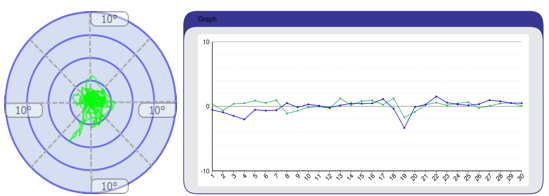
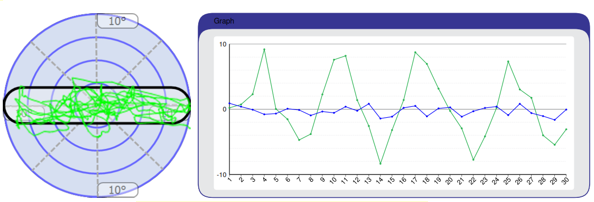
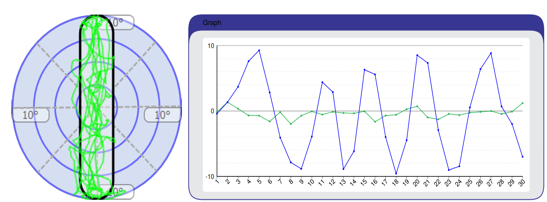
Measuring the dynamic balance with the Opto Jump Next system with feed-back (table
The assessment of the
The measurements concerning the amplitude of the foot extension were taken by using the nautical conditions simulator which provided us the possibility to identify the level of the ankle's flexibility expressed in centimeters. At the same time, the device also provided the level of the maximum force measured at the extension start moment, being expressed in daN. The subjects were tested alternatively, first on the right foot (fig. 05 and fig.
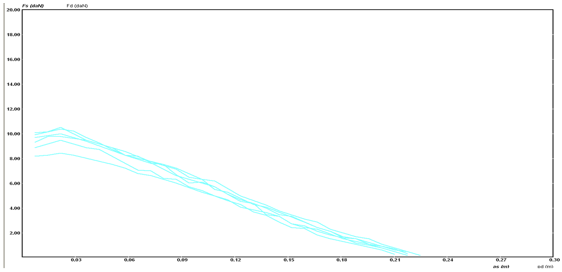
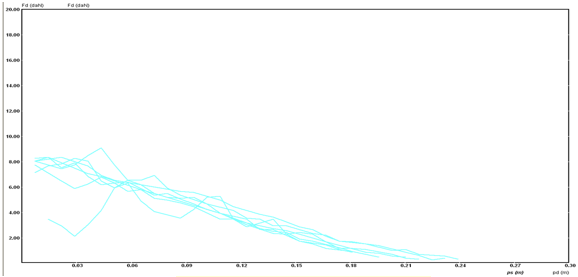
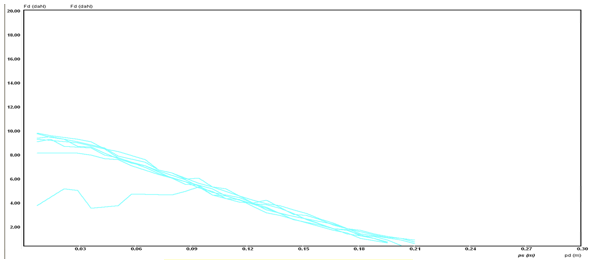
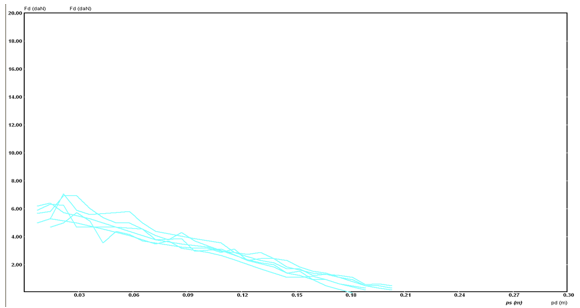
The use of the methodology presented above allows an objective diagnosis to be carried out on
the parameters, based on the appreciation of the recorded data. We have chosen to exemplify the presentation of the assessments related to the subject S1 for each of the tested indicators.
Thus, regarding to the static bipodal balance, the subject achieved a performance score of 87%, which can be appreciated as a good result, and the rating that can be attributed to it is good. In terms of proprioception, the subject has the same tendency, better in the side-to-side plane. In terms of dynamic balance in a horizontal sense, with a 87% performance score, the data signifies a good capacity (the left and right shifts in the graphics are represented in green), the dynamic balance being better on the right side. Regarding the dynamic balance in the vertical sense (forward and backwards represented graphically in blue), the performance score was 89%, which shows a steady to a very good balance. On the other hand, we can assume from the data analysis that the subject S1 exhibits a lower degree of ankle mobility during the extension movement compared to the flexion.
Measurements related to the unipodal balance in the right leg can highlight the following considerations: the static equilibrium capacity reveals a performance score of 85%, which may be similar to a good standard; dynamic balance capability has a more efficient vertical balance trend with a 83% performance score, with an anterior-posterior mobility that is superior to the sagittal plane (performance score of 73%). In terms of proprioception data, they have a performance score of 84%, showing a more efficient control capability in the horizontal plane, toward left. Tests that focused on left-handed unipodal balance showed a better static balance capacity (87% performance) compared to the right foot, with a better balance on the lateral side. Proprioception showed a score of 83%, with lateral differences to the left but also anterior-posterior to the back. As for mobility (dynamic balance), the data signifies a sagittal mobility (greater amplitude to the right) with a performance score of 72%, while in the anterior-posterior plane the movement is controlled very well with a 92% performance score.
The interpretation of the data that concerns the reaction speed test reveals a better response time on the right foot, both at visual and acoustic stimuli. Specific dynamic balance measured by the open eyes and closed eyes test - shows good values both from the point of view of the use of external feedback and from the use of intrinsic feedback. Regarding the amplitude of foot extension, measured by the condition simulator, we found that, at the right foot, the subject S1 exhibits a degree of mobility slightly inferior to the subject S2. It should be noted that the level of control, from the point of view of force and amplitude of executions of subject S1, was superior. In the left leg, the subject S1 shows higher values than the subject S2, both in terms of mobility and force control.
Conclusion
In conclusion, the working hypothesis according which by using instruments and apparatuses for measuring some parameters of the psychomotor skills we will be able to correctly assess and appreciate the specific physical training level of the athletes which will make the diagnosis more objective and provide objectives targets in the short and medium term sports outlook is confirmed. The methodology that was used allows the recording of objective, real-time data, which can be basic support elements in setting specific planning and monitoring parameters for training. At the same time, the logistics elements used can be implemented within the training methodology, and they can be integrated as testing and measurement means as well as tools for monitoring and conducting the training process.
Acknowledgments
We would like to thank the athletes that took part in our research and to their coaches for letting them to be tested.
References
- Colibaba Evuleţ, D., Bota, I. (1998). Sports games, theory and methods. Bucharest: Aldin.
- Dragnea, A., Teodorescu, S. (2002). Sport theory. Bucharest: FEST.
- http://www.optojump.com/What-is-Optojump. (2018.03.15). Retrieved from http://www.optojump.com/What-is-Optojump.aspx
- https://www.sensamove.com/en/sensbalance-miniboard/. (2018.03.17). Retrieved from https://www.sensamove.com/wp-content/uploads/2016/04/MiniBoard_Exercise_sheet_-_Ankle_-_110927_-_EN_Web.pdf
- http://www.donnamaria.ro/suport/index.html. (2018.03.15). Retrieved from http://www.donnamaria.ro/suport/index.html#simulator
- Manno, R., (1996). Theoretical bases of the sports training. Bucharest: CCPS and MTS.
- Mihăilescu, L. (2017). General bases of sports training, lecture notes. Pitesti: University of Pitesti.
- Nicu, A. (1993). The modern sports training. Bucharest: Editis.
- Weineck, J. (1997). Manual d, entrenament sportif [Sports training manual]. Paris: Vigot.
Copyright information

This work is licensed under a Creative Commons Attribution-NonCommercial-NoDerivatives 4.0 International License.
About this article
Publication Date
15 August 2019
Article Doi
eBook ISBN
978-1-80296-066-2
Publisher
Future Academy
Volume
67
Print ISBN (optional)
-
Edition Number
1st Edition
Pages
1-2235
Subjects
Educational strategies,teacher education, educational policy, organization of education, management of education, teacher training
Cite this article as:
Mihailescu*, L., Mihailescu, L., & Mihai, I. (2019). The Management Of Some Objective Parameters Determination Used In Performance Sports Diagnosis. In E. Soare, & C. Langa (Eds.), Education Facing Contemporary World Issues, vol 67. European Proceedings of Social and Behavioural Sciences (pp. 1669-1679). Future Academy. https://doi.org/10.15405/epsbs.2019.08.03.204
